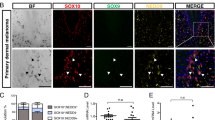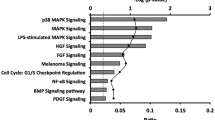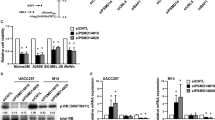Abstract
In this work, we studied the effects of CUB and Sushi multiple domains 1 gene (CSMD1) expression in A375 melanoma cells in vivo and in vitro. CSDM1 expression decreased proliferation and migration, and increased apoptosis and G1 arrest in A375 cells in vitro. Expression of CSDM1 in established xenografted tumors decreased tumor size and weight, and decreased the density of intratumor microvessels. The survival rate of mice with tumors expressing CSMD1 was significantly higher than mice with tumors that did not express CSDM1. These results confirm the role of CSDM1 as a tumor suppressor gene in melanoma cells. Furthermore, we found that CSMD1 can interact with Smad3, activate Smad1, Smad2, and Smad3, and increase the expression of Smad4. These results might prove helpful for the development of novel therapies for melanoma treatment.






Similar content being viewed by others
References
Diffey BL (2004) The future incidence of cutaneous melanoma within the UK. Br J Dermatol 151:868–872. doi:10.1111/j.1365-2133.2004.06216.x
Jemal A, Bray F, Center MM, Ferlay J, Ward E, Forman D (2011) Global cancer statistics. CA Cancer J Clin 61:69–90. doi:10.3322/caac.20107
Chin L, Garraway LA, Fisher DE (2006) Malignant melanoma: genetics and therapeutics in the genomic era. Genes Dev 20:2149–2182. doi:10.1101/gad.1437206
Helmbach H, Sinha P, Schadendorf D (2003) Human melanoma: drug resistance. Recent Results Cancer Res 161:93–110
Li Y, Mcclay EF (2002) Systemic chemotherapy for the treatment of metastatic melanoma. Semin Oncol 29:413–426. doi:10.1053/sonc.2002.35237
Soengas MS, Lowe SW (2003) Apoptosis and melanoma chemoresistance. Oncogene 22:3138–3151. doi:10.1038/sj.onc.1206454
Beddingfield FC 3rd (2003) The melanoma epidemic: res ipsa loquitur. Oncologist 8:459–465. doi:10.1634/theoncologist.8-5-459
Grossman D, Altieri DC (2001) Drug resistance in melanoma: mechanisms, apoptosis, and new potential therapeutic targets. Cancer Metastasis Rev 20:3–11. doi:10.1023/A:1013123532723
Agarwala SS, Kirkwood JM (1996) Interferons in melanoma. Curr Opin Oncol 8:167–174
Atkins MB (2000) Interleukin-2 in metastatic melanoma: what is the current role? Cancer J Sci Am 6:S8–S10
Atkins MB, Lotze MT, Dutcher JP, Fisher RI, Weiss G, Margolin K, Abrams J, Sznol M, Parkinson D, Hawkins M, Paradise C, Kunkel L, Rosenberg SA (1999) High-dose recombinant interleukin 2 therapy for patients with metastatic melanoma: analysis of 270 patients treated between 1985 and 1993. J Clin Oncol 17:2105–2116
Mitelman F, Mertens F, Johansson B (1997) A breakpoint map of recurrent chromosomal rearrangements in human neoplasia. Nat Genet 15:417–474
Forozan F, Mahlamäki EH, Monni O, Chen Y, Veldman R, Jiang Y, Gooden GC, Ethier SP, Kallioniemi A, Kallioniemi OP (2000) Comparative genomic hybridization analysis of 38 breast cancer cell lines: a basis for interpreting complementary DNA microarray data. Cancer Res 60:4519–4525
Anbazhagan R, Fujii H, Gabrielson E (1998) Allelic loss of chromosomal arm 8p in breast cancer progression. Am J Pathol 152:815–819
Sun J, Liu W, Adams TS, Sun J, Li X, Turner AR, Chang B, Kim JW, Zheng SL, Isaacs WB, Xu J (2007) DNA copy number alterations in prostate cancers: a combined analysis of published CGH studies. Prostate 67:692–700. doi:10.1002/pros.20543
Diep CB, Kleivi K, Ribeiro FR, Teixeira MR, Lindgjaerde OC, Lothe RA (2006) The order of genetic events associated with colorectal cancer progression inferred from meta-analysis of copy number changes. Genes Chromosomes Cancer 45:31–41. doi:10.1002/gcc.20261
Zhou W, Goodman SN, Galizia G, Lieto E, Ferraraccio F, Pignatelli C, Purdie CA, Piris J, Morris R, Harrison DJ, Paty PB, Culliford A, Romans KE, Montgomery EA, Choti MA, Kinzler KW, Vogelstein B (2002) Counting alleles to predict recurrence of early-stage colorectal cancers. Lancet 359:219–225. doi:10.1016/S0140-6736
Sun PC, Uppaluri R, Schmidt AP, Pashia ME, Quant EC, Sunwoo JB, Gollin SM, Scholnick SB (2001) Transcript map of the 8p23 putative tumor suppressor region. Genomics 75:17–25. doi:10.1006/geno.2001.6587
Kirkitadze MD, Barlow PN (2001) Structure and flexibility of the multiple domain proteins that regulate complement activation. Immunol Rev 180:146–161. doi:10.1034/j.1600-065X
Kamal M, Shaaban AM, Zhang L, Walker C, Gray S, Thakker N, Toomes C, Speirs V, Bell SM (2010) Loss of CSMD1 expression is associated with high tumour grade and poor survival in invasive ductal breast carcinoma. Breast Cancer Res Treat 12:555–563. doi:10.1007/s10549-009-0500-4
Ma C, Quesnelle KM, Sparano A, Rao S, Park MS, Cohen MA, Wang Y, Samanta M, Kumar MS, Aziz MU, Naylor TL, Weber BL, Fakharzadeh SS, Weinstein GS, Vachani A, Feldman MD, Brose MS (2009) Characterization CSMD1 in a large set of primary lung, head and neck, breast and skin cancer tissues. Cancer Biol Ther 8:907–916
Paris PL, Andaya A, Fridlyand J, Jain AN, Weinberg V (2004) Whole genome scanning identifies genotypes associated with recurrence and metastasis in prostate tumors. Hum Mol Genet 13:1303–1313. doi:10.1093/hmg/ddh155
Farrell LC, Crimm H, Meeh P, Croshaw R, Barbar T, Vandersteenhoven JJ, Butler W, Buckhaults P (2008) Somatic mutations to CSMD1 in colorectal adenocarcinomas. Cancer Biol Ther 7:609–613
Wright K, Wilson PJ, Kerr J, Do K, Hurst T, Khoo SK, Ward B, Chenevix-Trench G (1998) Frequent loss of heterozygosity and three critical regions on the short arm of chromosome 8 in ovarian adenocarcinomas. Oncogene 17:1185–1188
Henshall SM, Afar DE, Hiller J, Horvath LG, Quinn DI, Rasiah KK, Gish K, Willhite D, Kench JG, Gardiner-Garden M, Stricker PD, Scher HI, Grygiel JJ, Agus DB, Mack DH, Sutherland RL (2003) Survival analysis of genome-wide gene expression profiles of prostate cancers identifies new prognostic targets of disease relapse. Cancer Res 63:4196–4203
Midorikawa Y, Yamamato S, Tsuji S, Kamimura N, Ishikawa S, Igarashi H, Makuuchi M, Kokudo N, Sugimura H, Aburatani H (2008) Allelic imbalances and homozygous deletion on 8p23.2 for stepwise progression of hepatocarcinogenesis. Hepatology 49:513–522. doi:10.1002/hep.22698
Zhou S, Buckhaults P, Zawel L, Bunz F, Riggins G, Dai JL, Kern SE, Kinzler KW, Vogelstein B (1998) Targeted deletion of Smad4 shows it is required for transforming growth factor beta and activin signaling in colorectal cancer cells. Proc Natl Acad Sci USA 95:2412–2416
Schmierer B, Hill CS (2007) TGFbeta-SMAD signal transduction: molecular specificity and functional flexibility. Nat Rev Mol Cell Biol 8:970–982. doi:10.1038/nrm2297
Attisano L, Cárcamo J, Ventura F, Weis FM, Massagué J, Wrana JL (1993) Identification of human activin and TGF beta type I receptors that form heteromeric kinase complexes with type II receptors. Cell 75:671–680. doi:10.1016/0092-8674
Lux A, Attisano L, Marchuk DA (1999) Assignment of transforming growth factor beta1 and beta 3 and a third new ligand to the type I receptor ALK-1. J Biol Chem 274:9984–9992. doi:10.1074/jbc.274.15.9984
Lebrin F, Goumans MJ, Jonker L, Carvalho RL, Valdimarsdottir G, Thorikay M, Mummery C, Arthur HM, ten Dijke P (2004) Endoglin promotes endothelial cell proliferation and TGF-beta/ALK1 signal transduction. EMBO J 23:4018–4028. doi:10.1038/sj.emboj.7600386
Goumans MJ, Valdimarsdottir G, Itoh S, Lebrin F, Larsson J, Mummery C, Karlsson S, ten Dijke P (2003) Activin receptor-like kinase (ALK)1 is an antagonistic mediator of lateral TGFbeta/ALK5 signaling. Mol Cell 12:817–828. doi:10.1016/S1097-2765
Jacob D, Davis J, Zhu H, Zhang L, Teraishi F, Wu S, Marini FC 3rd, Fang B (2004) Suppressing orthotopic pancreatic tumor growth with a fiber-modified adenovector expressing the TRAIL gene from the human telomerase reverse transcriptase promoter. Clin Cancer Res 10:3535–3541. doi:10.1158/1078-0432
Zhu H, Zhang L, Huang X, Davis JJ, Jacob DA, Teraishi F, Chiao P, Fang B (2004) Overcoming acquired resistance to TRAIL by chemotherapeutic agents and calpain inhibitor I through distinct mechanisms. Mol Ther 9:666–673. doi:10.1016/j.ymthe.2004.02.007
Hahn SA, Hoque AT, Moskaluk CA, da Costa LT, Schutte M, Rozenblum E, Seymour AB, Weinstein CL, Yeo CJ, Hruban RH, Kern SE (1996) Homozygous deletion map at 18q21.1 in pancreatic cancer. Cancer Res 56:490–494
Goggins M, Shekher M, Turnacioglu K, Yeo CJ, Hruban RH, Kern SE (1998) Genetic alterations of the transforming growth factor beta receptor genes in pancreatic and biliary adenocarcinomas. Cancer Res 58:5329–5332
Thiagalingam S, Lengauer C, Leach FS, Schutte M, Hahn SA, Overhauser J, Willson JK, Markowitz S, Hamilton SR, Kern SE, Kinzler KW, Vogelstein B (1996) Evaluation of candidate tumour suppressor genes on chromosome 18 in colorectal cancers. Nat Genet 13:343–346. doi:10.1038/ng0796-343
Lazzereschi D, Nardi F, Turco A, Ottini L, D’Amico C, Mariani-Costantini R, Gulino A, Coppa A (2005) A complex pattern of mutations and abnormal splicing of Smad4 is present in thyroid tumours. Oncogene 24:5344–5354. doi:10.1038/sj.onc.1208603
Okano H, Shinohara H, Miyamoto A, Takaori K, Tanigawa N (2004) Concomitant overexpression of cyclooxygenase-2 in HER-2-positive on Smad4-reduced human gastric carcinomas is associated with a poor patient outcome. Clin Cancer Res 10:6938–6945. doi:10.1158/1078-0432
Alessandri G, Filippeschi S, Sinibaldi P, Mornet F, Passera P, Spreafico F, Cappa PM, Gullino PM (1987) Influence of gangliosides on primary and metastatic neoplastic growth in human and murine cells. Cancer Res 47:4243–4247
Ivkovic-Kapic T, Knelevic-Usaj S, Panjkovic M, Mastilovic K (2006) Immunohistochemical analysis of angiogenesis in invasive ductal breast carcinoma with correlations to clinicopathological factor. Vojnosanit Pregl 63:635–642
Bockmuhl U, Ishwad CS, Ferrell RE, Gollin SM (2001) Association of 8p23 deletions with poor survival in head and neck cancer. Otolaryngol Head Neck Surg 124:451–455. doi:10.1067/mhn.2001.114794
Kerbel RS (1997) A cancer therapy resistant to resistance. Nature 390:335–336. doi:10.1038/36978
Washburn JG, Wojno KJ, Dey J, Powell IJ, Macoska JA (2000) 8pter-p23 deletion is associated with racial differences in prostate cancer outcome. Clin Cancer Res 6:4647–4652
Van Belle P, Rodeck U, Nuamah I, Halpern AC, Elder DE (1996) Melanoma-associated expression of transforming growth factor-beta isoforms. Am J Pathol 148(6):1887–1894
Krasagakis K, Thölke D, Farthmann B, Eberle J, Mansmann U, Orfanos CE (1998) Elevated plasma levels of transforming growth factor (TGF)-beta1 and TGF-beta2 in patients with disseminated malignant melanoma. Br J Cancer 77(9):1492–1494
Heldin CH, Landström M, Moustakas A (2009) Mechanism of TGF-beta signaling to growth arrest, apoptosis, and epithelial-mesenchymal transition. Curr Opin Cell Biol 21(2):166–176. doi:10.1016/j.ceb.2009.01.021
Grau AM, Zhang L, Wang W, Ruan S, Evans DB, Abbruzzese JL, Zhang W, Chiao PJ (1997) Induction of p21waf1 expression and growth inhibition by transforming growth factor beta involve the tumor suppressor gene DPC4 in human pancreatic adenocarcinoma cells. Cancer Res 57(18):3929–3934
Guo Y, Kyprianou N (1998) Overexpression of transforming growth factor (TGF) beta1 type II receptor restores TGF-beta1 sensitivity and signaling in human prostate cancer cells. Cell Growth Differ 9(2):185–193
Wendt MK, Smith JA, Schiemann WP (2009) p130Cas is required for mammary tumor growth and transforming growth factor-beta-mediated metastasis through regulation of Smad2/3 activity. J Biol Chem 284:34145–34156. doi:10.1074/jbc.M109.023614
Acknowledgments
We thank Dr Zhang Hai for his valuable comments and excellent technical assistances. We also thank Dr Yu Fei for providing the plasmid pCDNA-3.0.
Conflict of interest
The authors declare no conflict of interest.
Author information
Authors and Affiliations
Corresponding author
Rights and permissions
About this article
Cite this article
Tang, MR., Wang, YX., Guo, S. et al. CSMD1 exhibits antitumor activity in A375 melanoma cells through activation of the Smad pathway. Apoptosis 17, 927–937 (2012). https://doi.org/10.1007/s10495-012-0727-0
Published:
Issue Date:
DOI: https://doi.org/10.1007/s10495-012-0727-0




